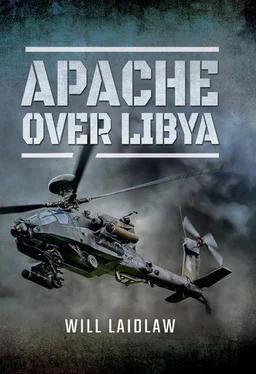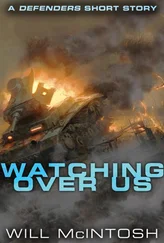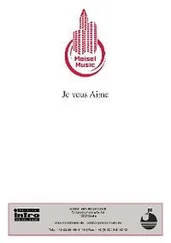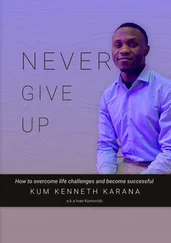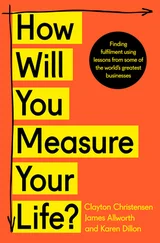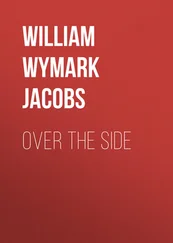‘Engines all good, keep coming up, good… come left of the deck… more… keep climbing… clear of the deck, transition.’
And John pushed the cyclic forward and we went from a 70ft hover over the sea into forward flight, rapidly gaining that crucial safe single engine speed. Twenty seconds behind us Little Shippers and Nick Stevens were doing the same. Within a minute they were in formation and we turned south.
John had dealt with my comms bewilderment and given me a singlepage diagram of who to speak to and on what frequency. He had simplified the whole massive document perfectly. I got on the Strike net and spoke to the AWACS controlling all NATO aircraft over Libya,
‘Matrix, Machete launched as fragged.’
Tonight Matrix was British: ‘Machete, parrots and India sweet. Continue.’ Matrix had us on his radar; the identification code we were transmitting was correct we were clear to proceed to our target.
Everything was done. We were on time, on course and in communication. I armed the counter-measures that would be used to decoy radars and incoming missiles, setting the flares to automatic dispense. John got us down to 100ft and we charged headlong towards the fearful unknown of Libya.
On my left MPD I flicked to the situational display. It showed a thin green line from the Apache icon at the bottom of the screen to the target in the middle. Beneath the Apache icon a text box read ‘18 nautical miles, 9 minutes 50 seconds to run’. Over my left eye I brought down a single Night Vision Goggle (NVG) tube attached to my helmet. The left eye now had two jobs: look inside at the MPDs and look outside through the NVG. The right eye continued interpreting the HMD symbology with infrared video superimposed from the FLIR mounted on the nose of the aircraft 3ft in front and 2ft below me. I now had my left eye looking for normal light and an NVG intensifying what little ambient light there was. This, with the HMD projecting the infrared end of the electromagnetic spectrum into my right eye, meant that if it had a light or a temperature we would see it. Above the rotor blades the Fire Control Radar searched for targets and beneath it the Radar Frequency Interferometer passively searched for any radars searching for us. We were fully armed, protected, all-seeing and very hostile to anyone who wanted to take us on.
I lowered my seat to the bottom of its limit, keeping as much of my body as possible within the armoured sanctuary surrounding the cockpit. In a fight I would rely on the FLIR to see out. In the rear seat John had no such safety. To fly, he had to look outside and to do this he needed good all-round vision outside the cockpit, so his seat was most of the way up. His NVG and HMD infrared were used to position the aircraft relative to the target and to keep an eye on our wingman. An extra piece of armour on the side of his seat slid forward to give some lateral protection. In combat the incoming would be from below and the layers of armour between the underside of the aircraft and the aircrew were designed to keep bullets and blast out. John’s job was to handle the aircraft whatever hell came from the ground, and this meant he would have to be able to see the ground and everything around him.
With six minutes to run we were still eleven nautical miles from the coastal radar target. I slaved the FLIR to the target coordinates and zoomed in the magnification, visually interrogating the coordinates. Its coastal location and our low height provided a perfectly silhouetted warm radar head. Even at this range it was already visible on infrared.
I described the picture to John: ‘Target visual, still 20km to run. It’s a great FLIR night!’
The conditions were perfect. A hot day had warmed the radar and it stood out against the relatively cool night sky. I knew Nick and Little Shippers would be looking at the same thing, so there was no need for a radio call. Looking outside and down I could see the gentle waves of sea state two just below us. It was perfect. Two Apaches, racing low-level over the sea, to a target in Libya. This was an extraordinary situation; we were about to join a new war. With the looming coast of Libya ahead and the clarity of the target, I knew we would be able to conduct the first part of the strike mission feet-wet. Staying over the sea meant I knew where the threat was, and that we would not overfly it and stand the chance of being ambushed.
‘All good, should get the missile off at long range and stay feet-wet. You okay?’ I said to John as I noticed a flashing green light reflecting off the canopy.
‘Yeah, good. Really dry mouth, lip-light on my microphone causing the light, sorry. Little bit of nerves.’
‘It’s all good, mate, all good. I better not miss or you’ll have to land, remember. I’d like to see your nerves then!’
I could deal with my worries by sitting low in the cockpit and keeping busy with the target countdown. John had to stay sitting up, eyes out, staring at Libya and wondering which of the thousands of bad things might happen first. Rear seat, hands on the flying controls – in combat that is where the courage is.
With four minutes to the target I actioned the missiles and counted down the range until we were less than 10km to go. With the situational display reading just under three minutes from the target I squeezed the right-hand trigger and placed the laser on the target. I was just seconds away from firing.
I was now dedicated to the shot. I searched all around the target with the FLIR. South of the radar by 400m was a dirt road. A track ran from the road to the radar. There was no movement, no vehicles and no people. Around the radar were three low buildings, clearly part of the radar site. They were damaged, presumably by previous strikes that had missed the radar itself. The radar was in good condition, the mast was straight and the radar on top was clean and facing north, out to sea.
‘There it is… No one about, no vehicles. Just one good-looking radar… and us.’ I described the target scene to John, who had now selected my video image on his right-hand MPD so that he could see my FLIR image and symbology too. He was now at a critical stage of flying. He had to maintain his awareness of the sea under us, the target in front of us, our proximity to both and the other aircraft and make sure he set the aircraft up so I could fire a missile.
Then, on our inter-aircraft net: ‘Target is good, no civilians, no movement. Call ready.’
Nick replied straight away: ‘Ready!’
With my right-hand middle finger pulling the laser trigger and my right thumb steering the crosshair, I placed the laser on the centre of the radar. A quick glance in at the right MPD, now showing the weapons page, and I checked that the missile was ready. Through the symbology in my right eye I noted it had locked on to the laser energy. The aircraft was perfectly set up to fire. Everything was ready, so I counted down the trigger pull.
My left-hand trigger finger lifted the heavy trigger-guard and then settled lightly on the lever. ‘Three, two, one… firing!’ Left trigger squeezed. A half-second delay and then a rushing whoosh and intense orange sparks accompanied the missile as it accelerated off the left-hand rail, climbed, gathered the laser energy and raced toward the target. My right hand held the laser dead centre on the radar, the missile seeker head tracking its reflected energy.
‘Good missile.’ John confirmed all post-firing checks were fine.
Then silence and the laser. Silence. No one spoke, radios hushed. Outside, darkness and a soaring missile ripping a trail toward war. Ten seconds later the missile hammered into the radar at over 700 miles an hour, its warhead punching through the delicate skin, followed a fraction of a second later by its fragmenting sleeve shredding the whole radar head. White-hot explosive fragments and debris sprayed out and showered to the ground. The first of ninety-nine Apache Hellfire had arrived in Libya.
Читать дальше
